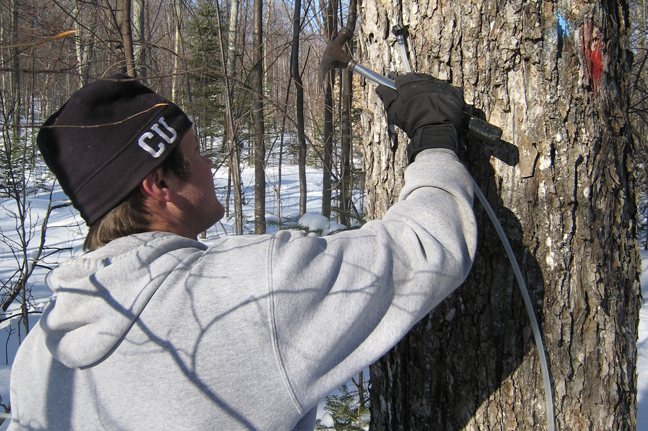Cornell Corner
Which spout is best for your operation?
By BRIAN CHABOT, STEVE CHILDS AND MICHAEL FARRELL |
In the past couple of years there has been a flurry of innovation in spout design each with their own claimed advantages for cost, ease of use, and sap yields.
In addition to research on spout and drop management at Proctor and Cornell, producers are doing their own research to determine which spout is best for their operation.
Cost is pretty straightforward. So is ease of use, unless you want to quantify this through time and motion studies. Producers will vary in their perception of ease of use.
The difficult variable is sap yield and requires careful design of experiments. To produce valid comparisons research designs must deal with several sources of variability that can produce false results.
False results can happen due to small sample sizes, failure to replicate tests, differences among trees and their locations, where spouts are placed, differences in collection systems, and differences in how sap volumes are measured. These sources of variation can be reduced through a common set of practices:
Trees should be about the same size and with similar site conditions (slope, spacing, soil types, moisture and snow depth)
Tapping should be in similar locations on the trunk, or similar variety of locations (half south-facing, half north-facing)
You should have similar numbers of trees on each collection system (they need not be exactly the same, but not greatly different. You will divide sap volume by number of trees)
Collection systems should be similar in terms of lengths and types of tubing and the vacuum at the spouts should be the same
How you measure sap volumes should be the same (if different instruments are used, they need to be calibrated)
Most of us use groups of trees, 10 to a few hundred. Larger numbers of trees help deal with variation between trees.
A common problem in producer experiments is lack of replication, multiple collection systems where everything should be the same.
The minimum number of replicates should be three. More is better. Replicated systems rarely produce the same numbers and you have to understand how variable the same treatments can be to have any faith in the results.
Then there is the replication across time. Those of us doing this type of research know that different weather can produce different results. Consequently we run our trials for several years to account for this source of variation.
If you have gotten this far you have a better idea about the challenges we deal with in designing useful experiments. We hope you are not discouraged. Producer experimentation has been very valuable over the years and we need more of it.
February 2013
































